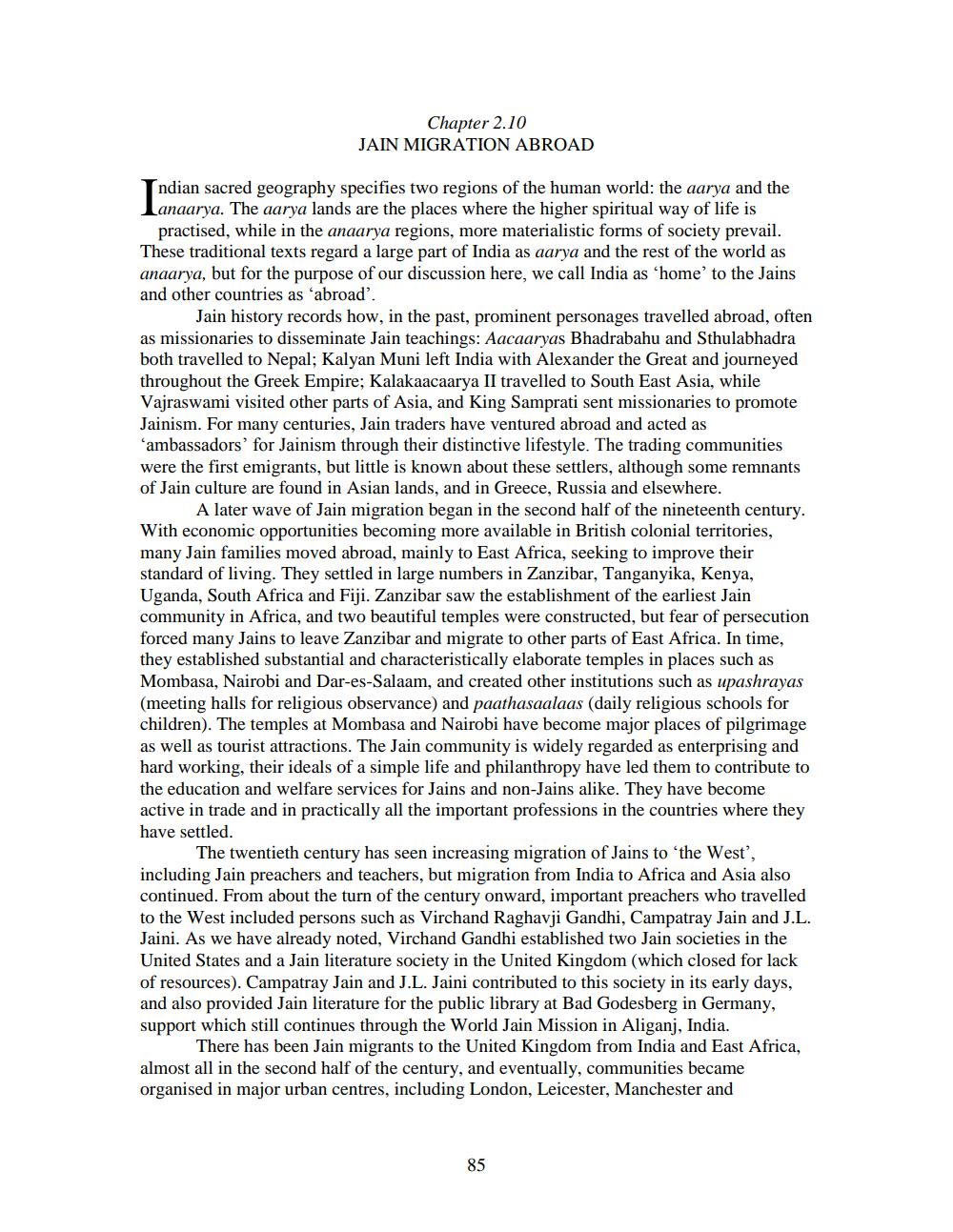________________
Chapter 2.10 JAIN MIGRATION ABROAD
Indi
ndian sacred geography specifies two regions of the human world: the aarya and the Lanaarya. The aarya lands are the places where the higher spiritual way of life is
practised, while in the anaarya regions, more materialistic forms of society prevail. These traditional texts regard a large part of India as aarya and the rest of the world as anaarya, but for the purpose of our discussion here, we call India as 'home' to the Jains and other countries as 'abroad'.
Jain history records how, in the past, prominent personages travelled abroad, often as missionaries to disseminate Jain teachings: Aacaaryas Bhadrabahu and Sthulabhadra both travelled to Nepal; Kalyan Muni left India with Alexander the Great and journeyed throughout the Greek Empire; Kalakaacaarya II travelled to South East Asia, while Vajraswami visited other parts of Asia, and King Samprati sent missionaries to promote Jainism. For many centuries, Jain traders have ventured abroad and acted as 'ambassadors' for Jainism through their distinctive lifestyle. The trading communities were the first emigrants, but little is known about these settlers, although some remnants of Jain culture are found in Asian lands, and in Greece, Russia and elsewhere.
A later wave of Jain migration began in the second half of the nineteenth century. With economic opportunities becoming more available in British colonial territories, many Jain families moved abroad, mainly to East Africa, seeking to improve their standard of living. They settled in large numbers in Zanzibar, Tanganyika, Kenya, Uganda, South Africa and Fiji. Zanzibar saw the establishment of the earliest Jain community in Africa, and two beautiful temples were constructed, but fear of persecution forced many Jains to leave Zanzibar and migrate to other parts of East Africa. In time, they established substantial and characteristically elaborate temples in places such as Mombasa, Nairobi and Dar-es-Salaam, and created other institutions such as upashrayas (meeting halls for religious observance) and paathasaalaas (daily religious schools for children). The temples at Mombasa and Nairobi have become major places of pilgrimage as well as tourist attractions. The Jain community is widely regarded as enterprising and hard working, their ideals of a simple life and philanthropy have led them to contribute to the education and welfare services for Jains and non-Jains alike. They have become active in trade and in practically all the important professions in the countries where they have settled.
The twentieth century has seen increasing migration of Jains to 'the West', including Jain preachers and teachers, but migration from India to Africa and Asia also continued. From about the turn of the century onward, important preachers who travelled to the West included persons such as Virchand Raghavji Gandhi, Campatray Jain and J.L. Jaini. As we have already noted, Virchand Gandhi established two Jain societies in the United States and a Jain literature society in the United Kingdom (which closed for lack of resources). Campatray Jain and J.L.. Jaini contributed to this society in its early days, and also provided Jain literature for the public library at Bad Godesberg in Germany, support which still continues through the World Jain Mission in Aliganj, India.
There has been Jain migrants to the United Kingdom from India and East Africa, almost all in the second half of the century, and eventually, communities became organised in major urban centres, including London, Leicester, Manchester and
85




